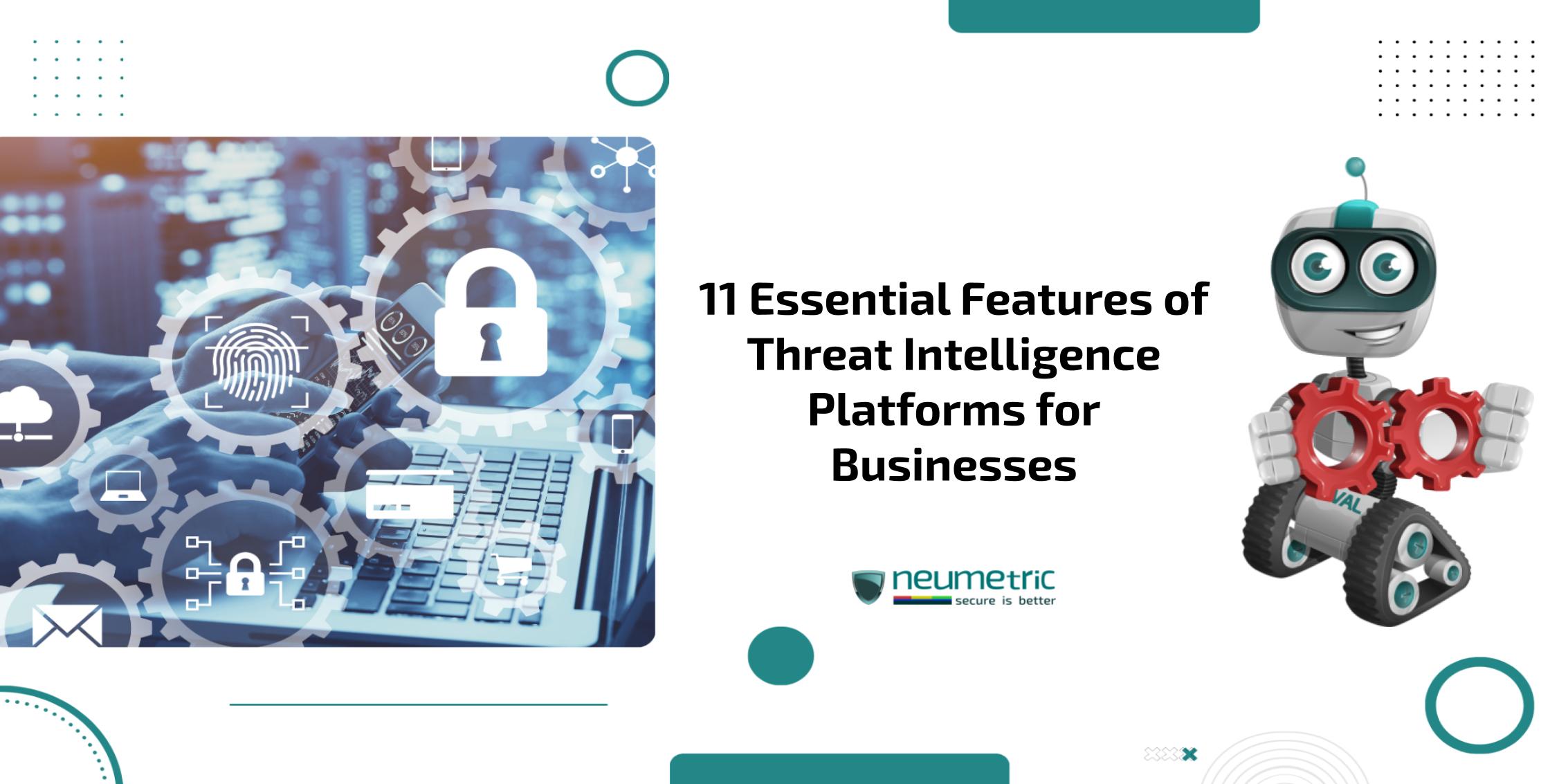Table of Contents
ToggleIntroduction
In today’s rapidly evolving digital landscape, businesses face an ever-increasing array of cyber threats. To stay ahead of these challenges, organizations are turning to Threat Intelligence platforms as a critical component of their cybersecurity strategy. These sophisticated tools provide invaluable insights & proactive measures to defend against potential attacks. In this comprehensive journal, we’ll explore the eleven (11) essential features that every Threat Intelligence platform for businesses should possess, helping you make informed decisions to protect your digital assets.
Understanding Threat Intelligence Platforms
Before diving into the essential features, it’s crucial to understand what threat intelligence platforms are & why they’re indispensable for modern businesses.
What is a Threat Intelligence Platform?
A Threat Intelligence platform is a comprehensive solution that collects, analyzes & disseminates information about potential cyber threats. These platforms aggregate data from various sources, including open-source intelligence, dark web monitoring & industry-specific threat feeds. By processing this vast amount of information, threat intelligence platforms provide businesses with actionable insights to enhance their security posture & respond swiftly to emerging threats.
The Importance of Threat Intelligence for Businesses
In an era where cyber attacks are becoming increasingly sophisticated & frequent, threat intelligence platforms serve as a crucial line of defense. They enable businesses to:
- Anticipate potential threats before they materialize
- Prioritize security efforts based on real-time risk assessments
- Reduce response times to security incidents
- Improve overall cybersecurity strategy & decision-making
Now that we’ve established the foundation, let’s explore the 11 essential features that make threat intelligence platforms indispensable for businesses.
Comprehensive Data Collection & Aggregation
The backbone of any effective threat intelligence platform is its ability to collect & aggregate data from a wide range of sources. This feature ensures that businesses have access to a holistic view of the threat landscape.
Key Aspects of Data Collection
- Integration with multiple threat feeds
- Real-time data ingestion capabilities
- Support for various data formats (e.g., STIX, TAXII)
- Ability to collect data from both internal & external sources
By casting a wide net, threat intelligence platforms for businesses can capture a diverse array of potential threats, from known malware signatures to emerging attack patterns.
The Power of Diverse Data Sources
To truly understand the threat landscape, platforms must tap into a variety of data sources. These may include:
- Open-source intelligence [OSINT]
- Dark web forums & marketplaces
- Social media platforms
- Industry-specific threat feeds
- Government & law enforcement agencies
- Security vendor reports & databases
The ability to aggregate & correlate data from these diverse sources provides businesses with a comprehensive view of potential threats, enabling them to make more informed security decisions.
Advanced Analytics & Machine Learning
Raw data alone is not enough to combat cyber threats effectively. Threat intelligence platforms must employ advanced analytics & machine learning algorithms to transform this data into actionable intelligence.
Benefits of Advanced Analytics
- Automated threat correlation & prioritization
- Anomaly detection to identify potential zero-day threats
- Predictive analysis to forecast future attack vectors
- Pattern recognition to uncover hidden relationships between threats
These sophisticated analytical capabilities enable businesses to stay one step ahead of cybercriminals, focusing their resources on the most critical threats.
Machine Learning in Threat Intelligence
Machine learning algorithms play a crucial role in modern threat intelligence platforms. They can:
- Improve threat detection accuracy over time
- Adapt to evolving attack patterns
- Reduce false positives & alert fatigue
- Automate complex analysis tasks
By leveraging machine learning, threat intelligence platforms can provide more accurate & timely insights, allowing businesses to respond more effectively to emerging threats.
Customizable Dashboards & Reporting
To make threat intelligence truly valuable, it must be presented in a clear, concise & customizable manner. Effective threat intelligence platforms offer intuitive dashboards & reporting features that cater to various stakeholders within an organization.
Key Dashboard & Reporting Features
- Real-time threat visualization
- Customizable widgets & metrics
- Role-based access controls
- Automated report generation & scheduling
By providing tailored views of threat intelligence, businesses can ensure that decision-makers at all levels have the information they need to take appropriate action.
The Importance of Data Visualization
Effective data visualization is crucial for making complex threat intelligence digestible. Key aspects include:
- Interactive charts & graphs
- Geospatial mapping of threats
- Timeline views for trend analysis
- Drill-down capabilities for detailed investigation
These visualization tools help security teams quickly identify patterns, anomalies & areas of concern, enabling faster & more informed decision-making.
Seamless Integration with Existing Security Infrastructure
For threat intelligence to be truly effective, it must seamlessly integrate with a business’s existing security infrastructure. This integration allows for a more coordinated & efficient response to potential threats.
Integration Capabilities to Look For
- Application Programming Interface [API] support for third-party tools & platforms
- Compatibility with Security Information & Event Management [SIEM] systems
- Integration with firewalls & intrusion detection/prevention systems [IDS/IPS]
- Support for Security Orchestration & Automated Response [SOAR] platforms
By ensuring smooth integration, threat intelligence platforms for businesses can enhance the overall effectiveness of their cybersecurity ecosystem.
The Role of APIs in Threat Intelligence Integration
Application Programming Interfaces [APIs] are crucial for enabling seamless integration. They allow:
- Real-time data exchange between systems
- Customization of threat intelligence feeds
- Automation of security workflows
- Development of tailored security applications
Robust Application Programming Interfaces [APIs] support ensures that businesses can fully leverage their threat intelligence platforms within their existing security infrastructure.
Automated Threat Hunting & Investigation
Proactive threat hunting is a critical component of modern cybersecurity strategies. Threat intelligence platforms should offer automated tools to facilitate this process, enabling security teams to uncover hidden threats & vulnerabilities.
Key Threat Hunting Features
- Automated threat hunting playbooks
- Customizable search queries & filters
- Historical data analysis capabilities
- Integration with MITRE ATT&CK framework
These features empower security teams to proactively identify & neutralize potential threats before they can cause significant damage.
The MITRE ATT&CK Framework in Threat Hunting
The MITRE ATT&CK framework provides a comprehensive knowledge base of adversary tactics & techniques. Integration with this framework allows threat intelligence platforms to:
- Map observed behaviors to known attack patterns
- Identify gaps in security coverage
- Prioritize threat hunting efforts
- Improve overall threat detection & response capabilities
By leveraging the MITRE ATT&CK framework, businesses can adopt a more structured & effective approach to threat hunting.
Real-time Alerting & Notification System
In the fast-paced world of cybersecurity, timely information is crucial. Threat intelligence platforms must provide real-time alerting & notification systems to ensure that businesses can respond swiftly to emerging threats.
Essential Alerting Features
- Customizable alert thresholds & criteria
- Multi-channel notifications (email, SMS, mobile apps)
- Automated escalation procedures
- Contextual information within alerts for quick decision-making
By delivering timely & relevant alerts, threat intelligence platforms enable businesses to take immediate action when faced with potential security incidents.
The Importance of Alert Prioritization
With the high volume of threats facing businesses today, alert prioritization is essential. Advanced threat intelligence platforms should offer:
- Risk-based alert scoring
- Automated triage of alerts
- Grouping of related alerts
- Integration of threat context for faster assessment
These features help security teams focus on the most critical threats, reducing alert fatigue & improving overall response times.
Comprehensive Threat Intelligence Sharing Capabilities
Collaboration is key in the fight against cyber threats. Effective threat intelligence platforms should facilitate secure sharing of threat information both within an organization & with trusted external partners.
Sharing Features to Look For
- Support for industry-standard sharing protocols (e.g., STIX/TAXII)
- Customizable sharing policies & access controls
- Anonymous sharing options for sensitive information
- Integration with threat intelligence sharing communities
By fostering collaboration, businesses can benefit from collective intelligence & stay informed about emerging threats across their industry.
The Benefits of Collaborative Threat Intelligence
Sharing threat intelligence offers numerous advantages to businesses:
- Faster identification of emerging threats
- Improved understanding of industry-specific risks
- Access to a broader range of expertise & resources
- Enhanced ability to respond to large-scale cyber attacks
By participating in threat intelligence sharing communities, businesses can strengthen their collective defense against cyber threats.
Dark Web Monitoring & Analysis
The deep web serves as a hub for cybercriminal activities.. Threat intelligence platforms for businesses should include robust dark web monitoring capabilities to uncover potential threats & stolen data.
Dark Web Monitoring Essentials
- Automated crawling of dark web forums & marketplaces
- Keyword & pattern-based monitoring
- Alerts for mentions of company-specific information
- Analysis of dark web trends & emerging threats
By shining a light on the dark web, businesses can gain valuable insights into potential threats & take proactive measures to protect their assets.
The Challenge of Dark Web Intelligence
Gathering intelligence from the dark web presents unique challenges:
- Access to hidden networks & encrypted communications
- Navigating complex & ever-changing criminal ecosystems
- Verifying the authenticity & relevance of information
- Balancing intelligence gathering with legal & ethical considerations
Advanced threat intelligence platforms employ specialized techniques & tools to overcome these challenges, providing businesses with valuable insights from this shadowy corner of the internet.
Vulnerability Management & Prioritization
Effective threat intelligence goes hand in hand with comprehensive vulnerability management. Threat intelligence platforms should provide features to identify, assess & prioritize vulnerabilities within an organization’s infrastructure.
Key Vulnerability Management Features
- Integration with vulnerability scanners & databases
- Risk-based vulnerability prioritization
- Automated patch management recommendations
- Continuous monitoring of asset vulnerability status
By linking threat intelligence with vulnerability management, businesses can focus their remediation efforts on the most critical weaknesses in their security posture.
The Role of Threat Intelligence in Vulnerability Prioritization
Threat intelligence can significantly enhance vulnerability management by:
- Providing context on how vulnerabilities are being exploited in the wild
- Identifying which vulnerabilities are most likely to be targeted
- Offering insights into the potential impact of successful exploits
- Helping prioritize patching efforts based on real-world threat data
This integration of threat intelligence & vulnerability management enables businesses to allocate their resources more effectively & reduce their overall risk exposure.
Threat Actor Profiling & Attribution
Understanding the motivations & tactics of threat actors is crucial for developing effective defense strategies. Threat intelligence platforms should offer robust capabilities for profiling & attributing malicious activities to specific threat actors or groups.
Threat Actor Intelligence Features
- Comprehensive threat actor databases
- Behavioral analysis & pattern recognition
- Geopolitical context & motivational insights
- Attribution confidence scoring
By gaining deeper insights into threat actors, businesses can better anticipate & defend against targeted attacks.
The Importance of Understanding Threat Actor Motivations
Profiling threat actors goes beyond simply identifying their tactics. It involves understanding:
- Financial, political or ideological motivations
- Preferred targets & industries
- Historical attack patterns & evolution of techniques
- Relationships & collaborations between different threat groups
This deep understanding allows businesses to develop more targeted & effective defense strategies, tailored to the specific threats they are most likely to face.
Scalability & Performance Optimization
As businesses grow & evolve, their threat intelligence needs will change. A robust threat intelligence platform should be scalable & optimized for performance to meet the changing demands of organizations.
Scalability & Performance Considerations
- Cloud-based deployment options
- Distributed architecture for handling large data volumes
- Caching & data optimization techniques
- Customizable data retention policies
By ensuring scalability & performance, threat intelligence platforms can continue to provide value as businesses expand their operations & face increasingly complex threats.
The Importance of Flexible Deployment Options
To meet the diverse needs of businesses, threat intelligence platforms should offer:
- On-premises deployment for organizations with strict data control requirements
- Cloud-based solutions for scalability & accessibility
- Hybrid options that combine on-premises & cloud capabilities
- Multi-tenant architectures for managed security service providers
These flexible deployment options ensure that businesses can implement threat intelligence solutions that align with their specific security & operational requirements.
Conclusion
In an era where cyber threats are constantly evolving, threat intelligence platforms have become indispensable tools for businesses seeking to protect their digital assets. By incorporating the 11 essential features outlined in this journal, organizations can significantly enhance their ability to detect, analyze & respond to potential security risks.
From comprehensive data collection & advanced analytics to seamless integration & scalability, these features work in concert to provide a holistic approach to cybersecurity. By leveraging the power of threat intelligence platforms, businesses can stay one step ahead of cybercriminals, make informed security decisions & build a more resilient digital infrastructure.
As the threat landscape continues to evolve, so too will the capabilities of threat intelligence platforms. By investing in these powerful tools & staying informed about emerging features & best practices, businesses can ensure they remain well-equipped to face the cybersecurity challenges of today & tomorrow.
In conclusion, the implementation of a robust threat intelligence platform is not just a luxury but a necessity for businesses operating in today’s digital environment. By carefully evaluating platforms based on the essential features discussed in this article, organizations can make informed decisions that will significantly strengthen their cybersecurity posture & protect their valuable assets from the ever-present threat of cyber attacks.
Key Takeaways
- Threat intelligence platforms are essential for businesses to stay ahead of cyber threats.
- Comprehensive data collection & advanced analytics form the foundation of effective threat intelligence.
- Customizable dashboards & seamless integration with existing security infrastructure are crucial for operationalizing threat intelligence.
- Automated threat hunting, real-time alerting & threat intelligence sharing capabilities enhance proactive security measures.
- Dark web monitoring, vulnerability management & threat actor profiling provide deeper insights into potential risks.
- Scalability & performance optimization ensure long-term value for growing businesses.
Frequently Asked Questions [FAQ]
What is the primary purpose of a threat intelligence platform for businesses?
The primary purpose of a threat intelligence platform is to collect, analyze & disseminate information about potential cyber threats. These platforms help businesses anticipate & respond to security risks more effectively by providing actionable insights & enhancing overall cybersecurity strategies.
How do threat intelligence platforms differ from traditional security tools?
Unlike traditional security tools that focus on detecting & preventing known threats, threat intelligence platforms take a more proactive approach. They aggregate data from various sources, use advanced analytics to identify emerging threats & provide context-rich insights to help businesses make informed security decisions.
Can threat intelligence platforms integrate with existing security infrastructure?
Yes, most modern threat intelligence platforms are designed to integrate seamlessly with existing security infrastructure. This integration typically includes support for Security Information & Event Management [SIEM] systems, firewalls, intrusion detection/prevention systems [IDS/IPS] & Security Orchestration & Automated Response [SOAR] platforms, allowing for a more coordinated & efficient security response.
How do threat intelligence platforms handle data privacy & compliance concerns?
Reputable threat intelligence platforms prioritize data privacy & compliance. They often include features such as data anonymization, access controls & customizable sharing policies. Additionally, many platforms adhere to industry standards & regulations like General Data Protection Regulation [GDPR], California Consumer Privacy Act [CCPA] & others to ensure data protection & compliance.
What is the Return on Investment [ROI] for implementing a threat intelligence platform?
The ROI of a threat intelligence platform can be significant, although it may vary depending on the organization’s size & security needs. Benefits often include reduced incident response times, improved threat detection rates & more efficient allocation of security resources. Many businesses report cost savings through prevented breaches & optimized security operations.





